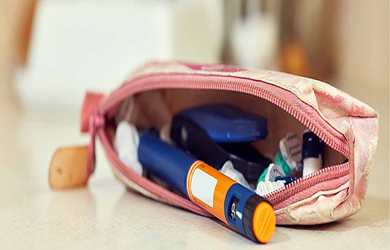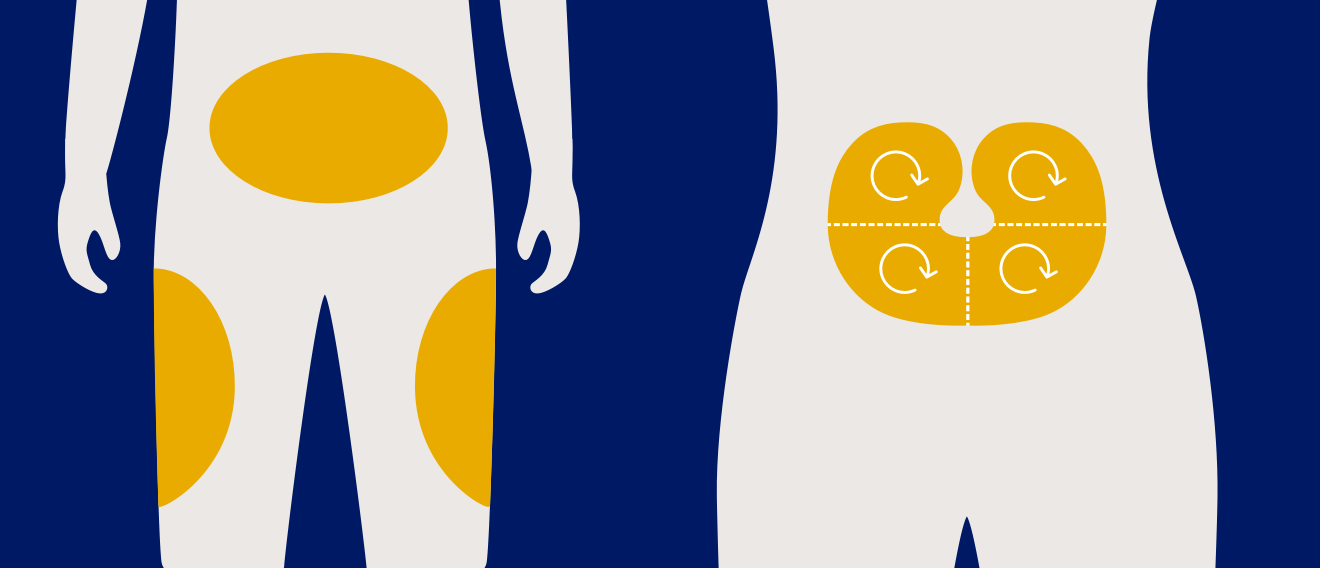Some people find the idea of giving injections to be overwhelming and
experience difficulty coping. We have developed this guide to help you
become more confident about performing injections.
Choosing the correct place to inject is important. The main injection
sites are the thighs, abdomen (stomach), buttocks or backs of the
upper arms.
- You should not inject in the same site every time
- Rotating injection sites will give each site the opportunity to
recover properly and will make injections more comfortable and
effective
- One rotation routine is to divide each injection
site into halves or quarters and use a different half or quarter
every week:
- At the beginning of each week, move in a
clockwise direction one finger-width from the last injection
point
Talk to your doctor or nurse about the injection sites and rotation
routines that are right for you.
Sharp objects like needles and skin pricks can be a source of
anxiety. When we think about injecting insulin, we often remember the
injections for immunisation, which are done with a longer, bigger
needle and given into muscle.
It is important to know the needles used to inject insulin are much
smaller and finer. Nevertheless, the anxiety from having to inject
with needles can still persist. Here are some tips and tricks you can
try to help you work through it.
There are many reasons why you might feel anxious when faced with
needles. Try to understand why you feel the way you feel about
needles, which could include:
- Not wanting to inject in public or in front of your
friends
- The association of needles with failure or your
disease severity
- The fear of pain or harm
- A fear
of needles specifically
Finding a way to relax will help with your anxiety. Make time in your
day to practice some form of relaxation technique, such as deep
breathing or guided meditations (in the form of CDs, books or mobile
apps). You can also try to incorporate one of these techniques into
your injection routine:
-
Take control: Write down your anxieties about injecting and
rate them on a scale from 1-10. Choose the least worrying aspect and
practice, practice, practice until it feels normal. Then, move up to
the next one…
-
Distract yourself: Try listening to music or talking to a
loved one while doing your injection to take the edge off
-
Take advice from others: Speak to other patients who
self-inject and find out how they first coped when starting out.
Search for local diabetes forums online or get in touch with your
local diabetes patient group for more tips and advice
-
Keep trying: Not all techniques will work for everyone. To
find the one that works for you, keep trying different ways to deal
with your needle anxiety or go back to your doctor or nurse
Remember, it takes time to feel comfortable with giving an injection
- do not rush yourself.
We understand that it is not easy to inject; no one enjoys injecting
every day. But, changing a few basic things can make the injection
procedure more comfortable:
-
Make sure your skin is clean and dry. You do not have to use
alcohol on your skin unless you have been in a hospital or are
unable to have your skin cleaned and dried with ordinary soap and
water. Wait for the alcohol from the swab to dry completely before
you inject
-
Inject insulin that is at room temperature. It is more
comfortable than when it is cold. Try and remember to take your
insulin out of the fridge well before you need it
-
Make your injection site “numb”. Using a frozen spoon or ice
cube wrapped in cloth, numbing cream from the pharmacy or even
simply applying pressure with your thumb to the injection site for a
few seconds before injecting can make the injection hurt less
-
Change your needle with each injection. Reusing your needle
increases the risk for infection and new needles are sharper and
cause less pain
-
Try and relax the muscles in the injection area
-
Rotate your injection site frequently to avoid damage to your
tissues


